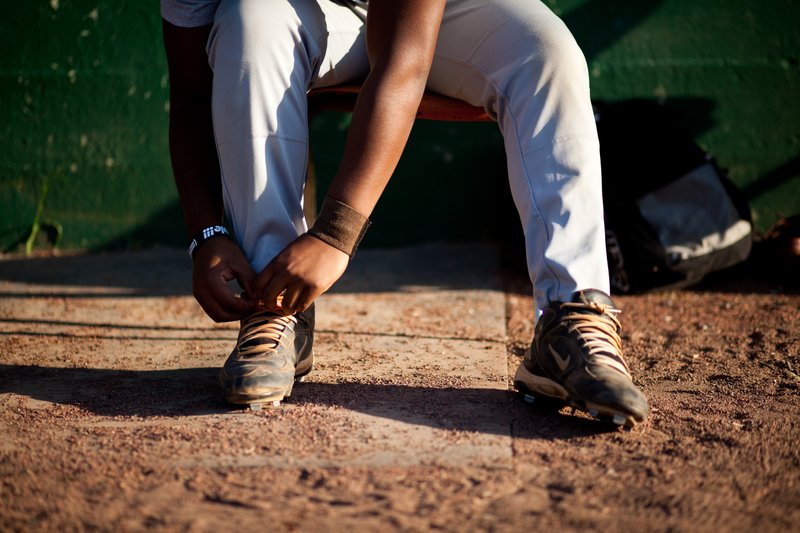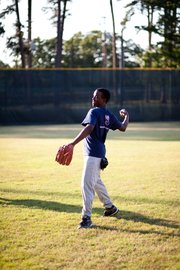For the most part, the bustle is gone.
It’s gone, with Winkler’s Drive-In, the carhops, jukeboxes and the pinball machines, too.
If it’s bustle you want, just walk a block south to Interstate 630. Thousands of cars, streaming west to a hundred separate communities. Sixty years ago, nobody was in that much of a hurry. The place to be was right here.
On the corner of Little Rock’s Seventh and Johnson streets is a 75-year-old ballpark, a monument to a golden past and cradle for a tenuous future.
Whole summers unspooled for the children and teens playing baseball in the confines of Lamar Porter Field. Their friends, neighbors and families filled its grandstands and played on the concrete ping-pong tables and in horseshoe pits of a nearby playground. Interest in youth league baseball was so high that even players as young as 8 years old had their exploits covered in a daily newspaper, which ran scores and highlights of each Little League game.
This was the age of Little League coach Benny Craig, the part-time Arkansas Travelers sportscaster who played an ongoing prank on his listeners. Craig concocted commentary on Travelers’ away games by mixing bare-bones information received from teletypes with his own imagination to fill in the rest. His commentary lagged about two innings behind the teletypes, and he used that lag time to plug his broadcast sponsor Colonial Bread, recalled Norris Guinn and Willis Callaway in Lamar Porter Field and Memories of Sports in Little Rock During the 1950s.
Most listeners didn’t know Craig could look ahead to see when the Travelers would score, so when he told them to put a loaf of Colonial Bread on their radio to help the Travelers score — making the bread seem like a good luck charm — the company’s bottom line was helped.
Whether for radio or TV, Craig always ended his broadcasts the same way: “Remember, it never takes an extra cent to be a good sport.” He would then wink and say “Good night.”
This world is long gone. In the intervening decades, of course, our culture changed. People stopped gathering as much in public. The popularity of baseball, once a cause for so many gatherings, waned. Lamar Porter games that once drew nearly 1,500 people now do well to hit 100 spectators. Baseball, which had thrived in nearly all neighborhoods and communities, mostly left the inner city for the suburbs.
This is where Reviving Baseball in Inner Cities steps in.
The summer program, run by Major League Baseball to promote the sport among poor, urban kids, is front and center in the renaissance of Arkansas’ oldest operating ballfield. The program took root in Little Rock in 2002 with one team of 13-to-15-year-olds and has since grown to include around 150 13-to-18-year-olds split into two age groups, says Wayne Gray, who helps direct Little Rock RBI.
The program is meant to break down barriers that have built up around baseball in recent decades. One is price: in a youth-league sports world where bats are priced up to $250 and gloves can go for $130, poor kids can have a tough go of it without aid. Little Rock RBI, and its sponsor Boys and Girls Club of Central Arkansas, provide funds for equipment and registration.
“A lot of these kids, you never see their parents,” says Harold Joyner, a coach in the 16-to-18-year-old league. “Coming up with the $30 for the Boys Club [registration] and the $30 for this program, it’s tough.” So, many participants receive scholarships covering all involved costs, he added.
The league also aims to give its players plenty of playing time, which separates it from more competitive youth leagues such as American Legion. Each player is guaranteed time on the field at least four innings a game, for instance. RBI encourages more than competition: it also promotes values such as courage and persistence that were espoused by Hall of Famer Jackie Robinson. Joyner says in American Legion, which he calls “all politics,” winning matters most; teams are formed to represent the best interests of the coaches instead of the players.
Race is another barrier RBI aims to topple. “Baseball’s not a black person sport predominantly,” says Terrell Hammond, the athletic director of Billy Mitchell Boys and Girls Club, which is adjacent to Lamar Porter Field.
Hammonds adds: RBI “gives black kids a chance.” Wayne Gray says the percentage of African-Americans involved in Little Rock’s RBI program has sharply risen in recent years, as kids in the Junior RBI program (ages 8-12) and 13-15 age group percolate into the older teen group. During a recent RBI practice for 16-to-18-year-olds, 25 of the 30 participants were black. Last year, about 60 percent of the older Little Rock RBI teens were black, Gray said.
Simple word of mouth has also helped. Christopher Dean, a rising senior on Hall High’s baseball team, said he joined the league last year in part to play more than he had in American Legion. He said two other Hall students joined him last year. They talked up the program to their peers, which has led to six Hall students coming out to the recent practice.
Dean has high goals. The centerfielder wants to get a scholarship to play college baseball, and after that is looking at Major League Baseball. If Dean, who wore a long-sleeve orange Under Armour shirt and immaculate white baseball pants, accomplishes this goal he will join two other Lamar Porter alumni who made the big leagues: Pat Seerey (class of 1941 Catholic High) and Brooks Robinson (class of 1955 Little Rock Central High).
It’s been a lifetime since the likes of Seerey and Robinson played here. Generations have passed since their contemporaries worked summertime gigs at Lamar Porter like scoreboard keeper, batboy, popcorn-popper and seat-duster, then exited through its pristine main concourse to spend hard-earned dimes on Royal Crown Cola and Moon Pies.
That rush of humanity has left the corner of Johnson and Seventh streets on early summer evenings. The paint peels from the concourse walls of Lamar Porter; rust is everywhere. On the far end of the hall there are light bulbs that at first seem dead. On closer inspection, they flicker.
Upkeep of Lamar Porter Field
Community still plays a large role in maintaining Lamar Porter Field, which annually costs between $15,000 and $18,000. Boys and Girls Club employees meet many of the day-in, day-out needs. Little Rock Catholic High and Episcopal Collegiate School pay $2,500 each spring to use the field for high school baseball season. Friends of Lamar Porter Field, an organization formed by people who grew up playing on the field, or had parents who did, donates about $5,000 a year, says Jay Rogers, one of the field’s trustees.
There have been recent improvements to Lamar Porter — an electronic scoreboard, a leveled field and a new outfield fence — but a thorough renovation of its structure awaits. The trustees have hired an architectural firm to study ways to improve the National Registry of Historic Places site, especially improving drainage and renovating the 75-year-old dugouts. After that study, a fundraising campaign will start. The goal is about $150,000.
Despite baseball’s waning popularity, Rogers believes there are still plenty of neighborhood kids who want to play. “What you have to have is a nice facility to attract them.”

